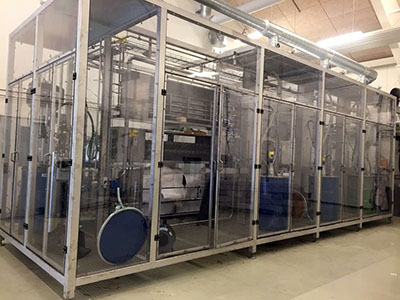New plant converts biomass to bio-oil
On 22 May 2015, Aarhus University is inaugurating an HTL pilot plant at AU Foulum. The new plant converts organic materials such as grass or organic waste into bio-crude oil, which can replace fossil oil for producing fuels and chemicals. The plant is based on newly developed, ground-breaking technologies.

The oil that is currently pumped up from the subsurface was formed between 10 and 160 million years ago. This took place with the deposition of organic material on the sea floor. As the material was gradually covered by new deposits, the pressure and temperature increased – and it was converted to crude oil.
This can be replicated by hydrothermal liquefaction (HTL) technology, a process in which organic material is mixed with water and exposed to high pressure and temperature. The result is a viscous oil that can be refined to diesel oil and a considerable number of other products.
The method has been known since the 1930s, but has never really taken off on a large scale, particularly because the process is connected with significant technological challenges. Some of these major challenges will possibly be solved with the new Foulum plant.
“The new plant is based on a flow reactor, with a steady inflow of biomass and an outflow of bio-oil from the other end. The process takes place in a 120-metre-long pipe, where the watery biomass is heated to 450 degrees and subjected to a pressure of up to 350 bar,” says Associate Professor Ib Johannsen, Department of Engineering, who is responsible for designing the plant.
The new plant will enable a continuous process in which pressure is maintained and heat loss is reduced by means of heat recovery. This means that the plant is expected to be far more energy-efficient than previous facilities.
“One of our parameters in the design of the pilot project is the recycling of a significant amount of the heat used to heat the biomass. Our aim is that the upgraded plant will be able to recycle as much as 85 per cent of the heat,” explains Associate Professor Johannsen.
The new plant is a pilot project, but the ambition is that the design can be scaled for commercial use.
If the technology proves to be sufficiently efficient, it could also contribute to solving a number of climate and environmental problems. The technology could first and foremost replace fossil fuels with bio-oil based on residual biomass.
Facilities will be set up beside the HTL plant for extracting proteins from green biomass, thereby creating a combined platform for biorefining on a pilot scale. This platform will be able to play alongside established activities at AU Foulum in fields such as biogas and harvest technology, as well as extensive experiments with improved resource efficiency in biomass production.
The overall platform will create new cultivation and production opportunities in agriculture. One of the options being investigated at present is replacing imported soy protein with grass protein grown in Denmark.
For more information about the HTL plant, please contact
Associate Professor Ib Johannsen
Department of Engineering
+45 2135 6050
ibj@eng.au.dk
